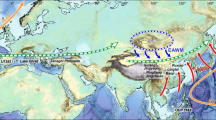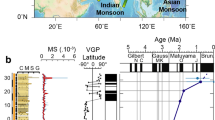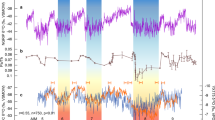Abstract
Many regions of the world experienced abrupt climate variability during the last glacial period (75–15 thousand years ago1,2). These changes probably arose from interactions between Northern Hemisphere ice sheets and circulation in the North Atlantic Ocean3, but the rapid and widespread propagation of these changes requires a large-scale atmospheric response whose details remain unclear4,5,6,7. Here we use an oxygen isotope record from a speleothem collected from the Cave of the Bells, Arizona, USA, to reconstruct aridity in the southwestern United States during the last glacial period and deglaciation. We find that, during this period, aridity in the southwestern United States and climate in the North Atlantic region show similar patterns of variability. Periods of warmth in the North Atlantic Ocean, such as interstadials and the Bølling–Allerød warming, correspond to drier conditions in the southwestern United States. Conversely, cooler temperatures in the high latitudes are associated with increased regional moisture. We propose that interstadial warming of the North Atlantic Ocean diverted the westerly storm track northward, perhaps through weakening of the Aleutian Low, and thereby reduced moisture delivery to southwestern North America. A similar response to future warming would exacerbate aridity in this already very dry region.
This is a preview of subscription content, access via your institution
Access options
Subscribe to this journal
Receive 12 print issues and online access
$259.00 per year
only $21.58 per issue
Buy this article
- Purchase on Springer Link
- Instant access to full article PDF
Prices may be subject to local taxes which are calculated during checkout



Similar content being viewed by others
References
Alley, R. B. et al. Abrupt climate change. Science 299, 2005–2010 (2003).
Overpeck, J. T. & Cole, J. E. Abrupt change in Earth’s climate system. Ann. Rev. Environ. Res. 31, 1–31 (2006).
Broecker, W. S. Abrupt climate change: causal constraints provided by the paleoclimate record. Earth Sci. Rev. 51, 137–154 (2000).
Leduc, G. et al. Moisture transport across Central America as a positive feedback on abrupt climatic changes. Nature 445, 908–911 (2007).
Peterson, L. C., Haug, G. H., Hughen, K. A. & Rohl, U. Rapid changes in the hydrologic cycle of the tropical Atlantic during the last glacial. Science 290, 1947–1951 (2000).
Stott, L., Poulsen, C., Lund, S. & Thunell, R. Super ENSO and global climate oscillations at millennial timescales. Science 297, 222–226 (2002).
Wang, Y. J. et al. A high-resolution absolute-dated Late Pleistocene monsoon record from Hulu Cave, China. Science 294, 2345–2348 (2001).
Barnett, T. P. et al. Human-induced changes in the hydrology of the western United States. Science 319, 1080–1083 (2008).
Cook, E. R., Seager, R., Cane, M. A. & Stahle, D. W. North American drought: Reconstructions, causes, and consequences. Earth Sci. Rev. 81, 93–134 (2007).
Anderson, R. S., Betancourt, J. L., Mead, J. I., Hevly, R. H. & Adam, D. P. Middle- and late-Wisconsin paleobotanic and paleoclimatic records from the southern Colorado Plateau, USA. Paleogeogr. Paleoclimatol. Paleoecol. 155, 31–57 (2000).
Pigati, J. S., Bright, J. E., Shanahan, T. M. & Mahan, S. A. Late Pleistocene paleohydrology near the boundary of the Sonoran and Chihuahuan deserts, southeastern Arizona, USA. Quat. Sci. Rev. 28, 286–300 (2009).
Dansgaard, W. et al. Evidence for general instability of past climate from a 250-kyr ice-core record. Nature 364, 218–220 (1993).
Johnsen, S. J. et al. Irregular glacial interstadials recorded in a new Greenland ice core. Nature 359, 311–313 (1992).
Svensson, A. et al. A 60 000 year Greenland stratigraphic ice core chronology. Clim. Past 4, 47–57 (2008).
Turney, C. S. M. et al. Millennial and orbital variations of El Nino/Southern Oscillation and high-latitude climate in the last glacial period. Nature 428, 306–310 (2004).
Cayan, D. R., Redmond, K. T. & Riddle, L. G. ENSO and hydrologic extremes in the western United States. J. Clim. 12, 2881–2893 (1999).
Enfield, D. B., Mestas-Nunez, A. M. & Trimble, P. J. The Atlantic multidecadal oscillation and its relation to rainfall and river flows in the continental US. Geophys. Res. Lett. 28, 2077–2080 (2001).
Zhang, R. & Delworth, T. L. Impact of the Atlantic multidecadal oscillation on North Pacific climate variability. Geophys. Res. Lett. 34, L23708 (2007).
Hendy, I. L. & Kennett, J. P. Dansgaard–Oeschger cycles and the California Current System: Planktonic foraminiferal response to rapid climate change in Santa Barbara Basin, Ocean Drilling Program hole 893A. Paleoceanography 15, 30–42 (2000).
Denniston, R. F. et al. Synchronous millennial-scale climatic changes in the Great Basin and the North Atlantic during the last interglacial. Geology 35, 619–622 (2007).
Winograd, I. J. et al. Devils Hole, Nevada, δO-18 record extended to the mid-Holocene. Quat. Res. 66, 202–212 (2006).
Benson, L., Lund, S., Negrini, R., Linsley, B. & Zic, M. Response of North American Great Basin Lakes to Dansgaard–Oeschger oscillations. Quat. Sci. Rev. 22, 2239–2251 (2003).
Kirby, M. E., Lund, S. P. & Bird, B. W. Mid-Wisconsin sediment record from Baldwin Lake reveals hemispheric climate dynamics (Southern CA, USA). Paleogeogr. Paleoclimatol. Paleoecol. 241, 267–283 (2006).
Okumura, Y., Deser, C., Hu, A., Timmermann, A. & Xie, S. P. North Pacific climate responses to freshwater forcing in the subarctic North Atlantic: Oceanic and atmospheric pathways. J. Clim. 22, 1424–1445 (2009).
Liu, Z. & Alexander, M. Atmospheric bridge, oceanic tunnel, and global climatic teleconnections. Rev. Geophys. 45, R62005 (2007).
Timmermann, A. et al. The influence of a weakening of the Atlantic meridional overturning circulation on ENSO. J. Clim. 20, 4899–4919 (2007).
Lu, R. Y., Dong, B. W. & Ding, H. Impact of the Atlantic multidecadal oscillation on the Asian summer monsoon. Geophys. Res. Lett. 33, L24701 (2006).
Steffensen, J. P. et al. High-resolution Greenland Ice Core data show abrupt climate change happens in few years. Science 321, 680–684 (2008).
Wang, X. F. et al. Millennial-scale precipitation changes in southern Brazil over the past 90,000 yr. Geophys. Res. Lett. 34, L23701 (2007).
Keenlyside, N. S., Latif, M., Jungclaus, J., Kornblueh, L. & Roeckner, E. Advancing decadal-scale climate prediction in the North Atlantic sector. Nature 453, 84–88 (2008).
Acknowledgements
We appreciate constructive comments from T. Ault, T. Broccoli, K. Dahl, I. Hendy, J. Overpeck and J. Quade, and useful critiques from two anonymous reviewers. Dripwater collection has been sustained by D. Hoburg, and permission to work at the Cave of the Bells was facilitated by J. Trout, US Forest Service. C. Eastoe and A. Long provided the Tucson precipitation isotopic data. This work was supported by the US National Science Foundation (Earth system history 03-18480), the University of Arizona (Faculty Small Grant program and Geosciences Department) and the Geological Society of America.
Author information
Authors and Affiliations
Contributions
J.E.C., J.W.B. and P.J.P. conceived the study. J.D.M.W., P.J.P. and G.M.H. implemented the U/Th analyses. J.D.M.W., H.R.B. and J.E.C. implemented the stable isotopic analyses. All authors participated in data discussion and interpretation. J.E.C. and J.D.M.W. wrote the initial manuscript, and all authors provided substantial comments and editorial revisions to the manuscript.
Corresponding author
Ethics declarations
Competing interests
The authors declare no competing financial interests.
Supplementary information
Supplementary Information
Supplementary Information (PDF 958 kb)
Rights and permissions
About this article
Cite this article
Wagner, J., Cole, J., Beck, J. et al. Moisture variability in the southwestern United States linked to abrupt glacial climate change. Nature Geosci 3, 110–113 (2010). https://doi.org/10.1038/ngeo707
Received:
Accepted:
Published:
Issue Date:
DOI: https://doi.org/10.1038/ngeo707



